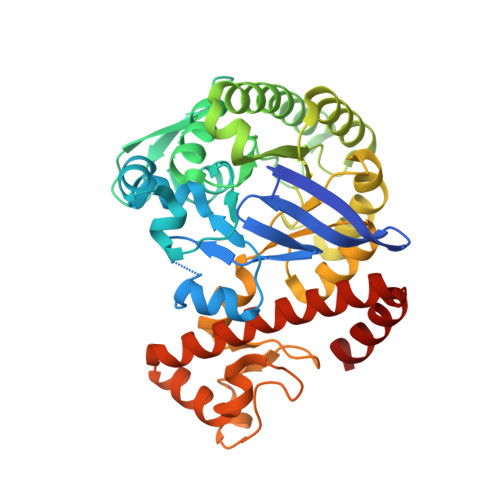What Glues a Homodimer Together: Systematic Analysis of the Stabilizing Effect of an Aromatic Hot Spot in the Protein-Protein Interface of the tRNA-Modifying Enzyme Tgt.
Jakobi, S., Nguyen, P.T., Debaene, F., Cianferani, S., Reuter, K., Klebe, G.(2015) ACS Chem Biol 10: 1897-1907
- PubMed: 25951081
- DOI: https://doi.org/10.1021/acschembio.5b00028
- Primary Citation of Related Structures:
4DY1, 4HTB, 4L56 - PubMed Abstract:
Shigella bacteria constitute the causative agent of bacillary dysentery, an acute inflammatory disease causing the death of more than one million humans per year. A null mutation in the tgt gene encoding the tRNA-modifying enzyme tRNA-guanine transglycosylase (Tgt) was found to drastically decrease the pathogenicity of Shigella bacteria, suggesting the use of Tgt as putative target for selective antibiotics. The enzyme is only functionally active as a homodimer; thus, interference with the formation of its protein-protein interface is an attractive opportunity for therapeutic intervention. To better understand the driving forces responsible for the assembly, stability, and formation of the homodimer, we studied the properties of the residues that establish the dimer interface in detail. We performed site-directed mutagenesis and controlled shifts in the monomer/dimer equilibrium ratio in solution in a concentration-dependent manner by native mass spectrometry and used crystal structure analysis to elucidate the geometrical modulations resulting from mutational variations. The wild-type enzyme exhibits nearly exclusive dimer geometry. A patch of four aromatic amino acids, embedded into a ring of hydrophobic residues and further stabilized by a network of H-bonds, is essential for the stability of the dimer's contact. Accordingly, any perturbance in the constitution of this aromatic patch by nonaromatic residues reduces dimer stability significantly, with some of these exchanges resulting in a nearly exclusively monomeric state. Apart from the aromatic hot spot, the interface comprises an extended loop-helix motif that exhibits remarkable flexibility. In the destabilized mutated variants, the loop-helix motif adopts deviating conformations in the interface region, and a number of water molecules, penetrating into the interface, are observed.
Organizational Affiliation:
?Institut f¨¹r Pharmazeutische Chemie, Philipps-Universit?t Marburg, Marbacher Weg 6, D-35032 Marburg, Germany.

















